
The British Indian Army, commonly referred to as the Indian Army, was the main military force of the British Raj before its dissolution in 1947. It was responsible for the defence of the British Indian Empire, including the princely states, which could also have their own armies. As quoted in the Imperial Gazetteer of India, "The British Government has undertaken to protect the dominions of the Native princes from invasion and even from rebellion within: its army is organized for the defence not merely of British India, but of all possessions under the suzerainty of the King-Emperor." The Indian Army was an important part of the forces of the British Empire, in India and abroad, particularly during the First World War and the Second World War.
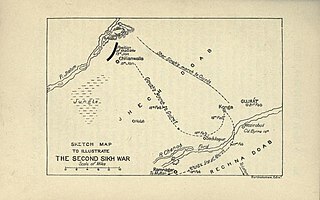
The Second Anglo-Sikh War was a military conflict between the Sikh Empire and the East India Company that took place in 1848 and 1849. It resulted in the fall of the Sikh Empire, and the annexation of the Punjab and what subsequently became the North-West Frontier Province, by the East India Company.

The North-West Frontier was a region of the British Indian Empire. It remains the western frontier of present-day Pakistan, extending from the Pamir Knot in the north to the Koh-i-Malik Siah in the west, and separating the modern Pakistani frontier regions of North-West Frontier Province, Federally Administered Tribal Areas and Balochistan from neighbouring Afghanistan in the west. The borderline between is officially known as the Durand Line and divides Pashtun inhabitants of these provinces from Pashtuns in eastern Afghanistan.

The Governor General's Bodyguard was a cavalry regiment of the British Indian Army and served as the British Indian equivalent to the Household Cavalry of the British Army.

The Battle of Kabul was part of a punitive campaign undertaken by the British against the Afghans following the disastrous retreat from Kabul. Two British and East India Company armies advanced on the Afghan capital from Kandahar and Jalalabad to avenge the complete annihilation of the British-Indian military-civilian column in January 1842. Having recovered prisoners captured during the retreat, the British demolished parts of Kabul before withdrawing to India. The action was the concluding engagement to the First Anglo-Afghan War.
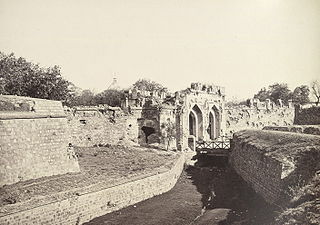
The siege of Delhi was one of the decisive conflicts of the Indian Rebellion of 1857.

4th Horse (Hodson's Horse) is a part of the Armoured Corps of the Indian Army, which had its beginnings as an irregular cavalry regiment during the time of the Indian Rebellion of 1857.
The 5th Bengal European Cavalry was a cavalry regiment of the East India Company, created in 1858 and disbanded in 1859.
The 4th Bengal European Cavalry was a cavalry regiment of the British East India Company, created in 1858 and disbanded in 1859.
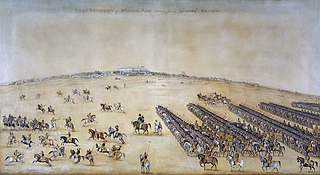
The 1st Horse (Skinner's Horse) is a regiment of the Armoured Corps of the Indian Army. It traces its origins as a cavalry regiment from the times of the East India Company, followed by its service in the British Indian Army and finally, after independence as the fourth oldest and one of the senior cavalry regiments of the Armoured Corps of the Indian Army.

The 7th Hariana Lancers was a cavalry regiment in the British Indian Army. It was raised in Meerut and Cawnpore in 1846 by Captain J. Liptrott as a regiment of Bengal irregular cavalry. The regiment was amalgamated with the 6th King Edward's Own Cavalry to form the 18th King Edward's Own Cavalry.

The 14th Murray's Jat Lancers, also sometimes known as the Murray's Jat Horse, was a cavalry regiment of the British Indian Army.

The Bengal Army was the army of the Bengal Presidency, one of the three presidencies of British India within the British Empire.

The regiments of Bengal Native Infantry, alongside the regiments of Bengal European Infantry, were the regular infantry components of the East India Company's Bengal Army from the raising of the first Native battalion in 1757 to the passing into law of the Government of India Act 1858. At this latter point control of the East India Company's Bengal Presidency passed to the British Government. The first locally recruited battalion was raised by the East India Company in 1757 and by the start of 1857 there were 74 regiments of Bengal Native Infantry in the Bengal Army. Following the Mutiny the Presidency armies came under the direct control of the United Kingdom Government and there was a widespread reorganisation of the Bengal Army that saw the Bengal Native Infantry regiments reduced to 45.

The 5th Horse is an armoured regiment of the Pakistan Army. It was previously known as the 5th King Edward's Own Probyn's Horse, which was a regular cavalry regiment of the British Indian Army. It was formed in 1921 by the amalgamation of the 11th King Edward's Own Lancers (Probyn's Horse) and the 12th Cavalry.
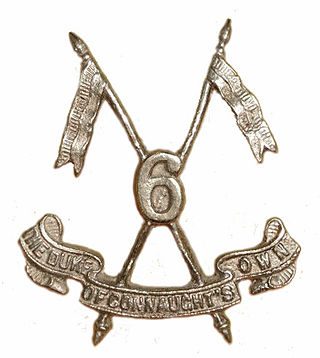
The 6th Lancers is an armoured regiment of the Pakistan Army. Previously, it was known as the 6th Duke of Connaught's Own Lancers (Watson's Horse), and was a regular cavalry regiment in the British Indian Army. It was formed in 1921 by amalgamation of the 13th Duke of Connaught's Lancers (Watson's Horse) and the 16th Cavalry. The regiment and its predecessors have seen active service on the North West Frontier, in Egypt during 1882, in China during the Boxer Rebellion, the two World Wars and the Indo-Pakistani War of 1965. On the Partition of India in 1947, the regiment was allotted to the Pakistan Army, where it remains in service today.
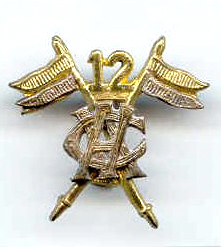
The 12th Cavalry Sam Browne's Cavalry (Frontier Force) is an armoured regiment of Pakistan Army. It was formed in the British Indian army in 1922 by the amalgamation of 22nd Sam Browne's Cavalry (Frontier Force) and 25th Cavalry (Frontier Force).

The Bombay Army was the army of the Bombay Presidency, one of the three presidencies of British India.

Sir Hugh Massy Wheeler KCB was an Irish-born officer in the army of the East India Company. He commanded troops in the First Anglo-Afghan War, and the First and Second Anglo-Sikh Wars, and in 1856 was appointed commander of the garrison at Cawnpore. He is chiefly remembered for the disastrous end to a long and successful military career, when his defence of Wheeler's entrenchment and surrender to Nana Sahib during the Indian Rebellion of 1857 led to the annihilation of almost all the European, Eurasian and Christian Indian population of Cawnpore, himself and several members of his family included.

The 3rd Bengal Light Cavalry, also known as the 3rd Bengal Native Cavalry, was a locally recruited regiment of the East India Company's Bengal Army. Raised in 1797, the regiment took part in conflicts throughout British India, serving with distinction in the Second Anglo-Maratha War, the First Anglo-Afghan War and the First Anglo-Sikh War, earning various battle honours.














